Circuit training is the first stage of practical pilot training focused on take-offs and landings. It involves the pilot making approaches to the runway, touching down and then applying power to take off again (commonly known as a “touch and go”).
Circuit training is undertaken in accordance with Civil Aviation Safety Authority (CASA) Regulations which are consistent with international practices. The size and location of the circuit is controlled to ensure the safety of all aircraft operations at the airport. This may result in training being undertaken over residential areas, especially where these are in close proximity to the airport, and also at night time.
A training circuit consists of five legs – the take-off, crosswind, downwind, base and final approach to the runway. The take off and final stage of the circuit is flown into the wind, as this is the safest way for an aircraft to operate.
At Port Macquarie Airport, circuit training is conducted with a standard left hand (the most common) circuit, meaning that aircraft turn left after take-off and fly in an anticlockwise direction around the Airport.
What are the circuit training hours of operation?
There are no regulated hours for circuit training, but most airports like Port Macquarie have local agreements in place to avoid circuits during the late night to early morning, typically 10pm to 7am.
We work closely with local aircraft operators to limit the majority of circuit training to the following hours to minimise disruption to nearby residents:
Monday to Friday
- 0700hrs - 2200hrs AEDT
- 0700hrs - 2100hrs AEST
Saturday
Sunday and Public Holidays
- No continuous circuit training
Other non-training aircraft arriving or departing the Airport are not subject to these training limits and may still need to fly around the circuit to land safely. Please note however, that under the agreement, recreational aircraft may commence continuous circuit training from 0600hrs weekdays and that operators may catch up on lost time caused by weather, airspace, technical or other disruptions, on Sundays between 0800hrs and 1600hrs.
